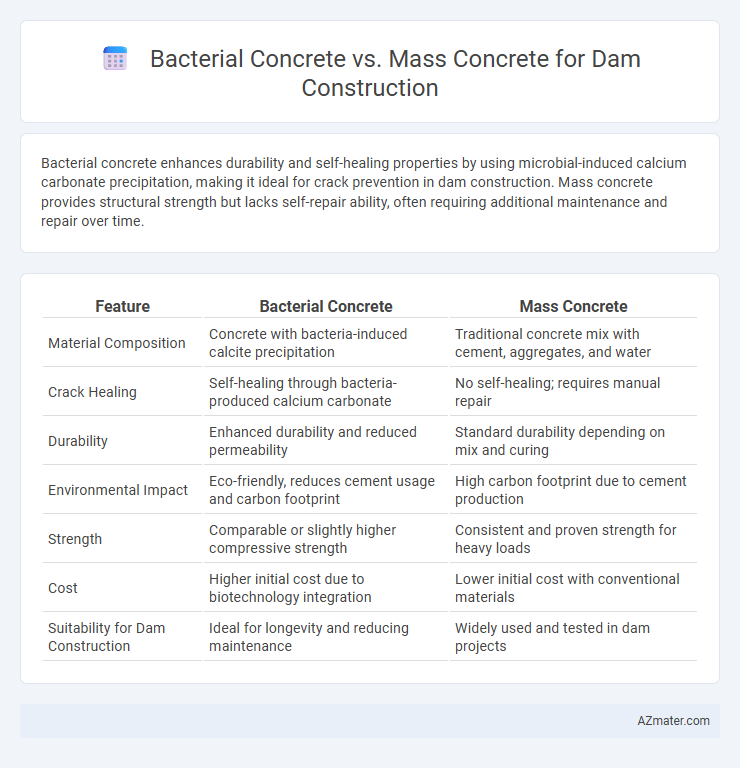Bacterial concrete enhances durability and self-healing properties by using microbial-induced calcium carbonate precipitation, making it ideal for crack prevention in dam construction. Mass concrete provides structural strength but lacks self-repair ability, often requiring additional maintenance and repair over time.
Table of Comparison
| Feature | Bacterial Concrete | Mass Concrete |
|---|---|---|
| Material Composition | Concrete with bacteria-induced calcite precipitation | Traditional concrete mix with cement, aggregates, and water |
| Crack Healing | Self-healing through bacteria-produced calcium carbonate | No self-healing; requires manual repair |
| Durability | Enhanced durability and reduced permeability | Standard durability depending on mix and curing |
| Environmental Impact | Eco-friendly, reduces cement usage and carbon footprint | High carbon footprint due to cement production |
| Strength | Comparable or slightly higher compressive strength | Consistent and proven strength for heavy loads |
| Cost | Higher initial cost due to biotechnology integration | Lower initial cost with conventional materials |
| Suitability for Dam Construction | Ideal for longevity and reducing maintenance | Widely used and tested in dam projects |
Introduction to Dam Construction Materials
Bacterial concrete incorporates microbial-induced calcite precipitation to enhance durability and self-healing properties, making it an innovative alternative in dam construction materials. Mass concrete, traditionally used in dam construction, comprises large volumes of concrete characterized by its thermal control and structural strength capabilities. The selection between bacterial and mass concrete depends on factors such as environmental conditions, structural requirements, and long-term maintenance considerations.
Overview of Bacterial Concrete Technology
Bacterial concrete technology utilizes specific microorganisms to induce calcium carbonate precipitation, enhancing the self-healing properties and durability of concrete used in dam construction. This bio-mediated process reduces crack formation and permeability compared to traditional mass concrete, thus extending the lifespan and structural integrity of dams. Incorporating bacterial concrete significantly improves resistance to chemical attacks and environmental stressors, making it a sustainable alternative for large-scale hydraulic structures.
Fundamentals of Mass Concrete in Dams
Mass concrete in dam construction primarily involves large volumes of concrete to resist immense hydrostatic pressures, relying on controlled heat of hydration and minimizing thermal gradients to prevent cracking. Bacterial concrete introduces self-healing properties through microbial-induced calcite precipitation, enhancing durability but remains less studied compared to traditional mass concrete's well-established principles in thermal management, curing, and structural stability. Understanding the fundamentals of mass concrete, including temperature control, aggregate selection, and staged placement, is crucial for ensuring dam safety and longevity under extreme loading conditions.
Strength Characteristics Comparison
Bacterial concrete exhibits enhanced strength characteristics compared to mass concrete due to its self-healing properties and ability to fill micro-cracks through bacterial calcite precipitation, resulting in increased durability and reduced permeability. Mass concrete typically relies on its volume and density for structural stability but may suffer from shrinkage cracks and lower tensile strength over time. The integration of bacteria in concrete matrices significantly improves compressive and tensile strength, making bacterial concrete a superior choice for dam construction where long-term strength and crack resistance are critical.
Durability and Longevity Factors
Bacterial concrete enhances durability and longevity in dam construction by utilizing microbial-induced calcite precipitation to heal microcracks, reducing permeability and preventing water ingress. Mass concrete, typically composed of large volumes of conventional concrete, may experience thermal cracking and durability issues due to heat of hydration and shrinkage over time. The incorporation of bacterial concrete significantly improves resistance to environmental degradation and chemical attacks, leading to extended service life compared to traditional mass concrete in dam structures.
Environmental and Sustainability Considerations
Bacterial concrete enhances dam construction sustainability by promoting self-healing through microbial-induced calcium carbonate precipitation, reducing crack formation and extending the structure's lifespan, thus lowering maintenance resources and carbon emissions related to frequent repairs. Mass concrete, typically composed of large volumes of conventional cementitious materials, contributes significantly to CO2 emissions during production and may face durability challenges such as thermal cracking, leading to increased environmental impact over time. Utilizing bacterial concrete in dams aligns with green infrastructure goals by minimizing ecological footprints through bio-based processes and optimizing resource efficiency compared to traditional mass concrete methods.
Cost Analysis: Bacterial vs Mass Concrete
Bacterial concrete reduces long-term maintenance costs by enhancing durability and self-healing properties, lowering crack repair expenses compared to mass concrete. Initial costs are higher for bacterial concrete due to specialized microbial additives and cultivation processes, but these are offset by extended service life and reduced downtime in dam construction projects. Mass concrete offers lower upfront costs but incurs higher maintenance and repair expenses, making bacterial concrete more cost-effective in large-scale dam applications over time.
Crack Resistance and Self-Healing Capabilities
Bacterial concrete significantly enhances crack resistance and self-healing capabilities in dam construction due to the bio-mineralization process where bacteria precipitate calcium carbonate, effectively sealing micro-cracks and preventing water ingress. In contrast, mass concrete relies primarily on its density and mix design for crack resistance, lacking the intrinsic ability to autonomously repair damage, which increases maintenance needs over the dam's lifespan. The incorporation of bacterial concrete in dams offers sustainable structural integrity by reducing permeability and extending service life through biologically-induced self-healing mechanisms.
Construction and Maintenance Implications
Bacterial concrete enhances self-healing capabilities by utilizing microbial-induced calcite precipitation, reducing crack formation and minimizing maintenance requirements in dam construction. In contrast, mass concrete relies heavily on conventional curing and quality control techniques to prevent cracks and thermal stresses, leading to more frequent inspections and repairs. The integration of bacterial concrete can lower long-term maintenance costs and improve structural durability compared to traditional mass concrete.
Future Trends in Dam Concrete Innovation
Bacterial concrete offers self-healing properties through microbial-induced calcite precipitation, reducing maintenance costs and extending dam lifespan compared to traditional mass concrete used in dam construction. Future trends emphasize integrating nanotechnology and bio-based additives to enhance durability, permeability resistance, and structural health monitoring in dam concrete. Advances in sustainable materials and smart sensors are poised to revolutionize dam construction by increasing resilience against environmental stressors and reducing carbon footprints.

Infographic: Bacterial concrete vs Mass concrete for Dam construction
 azmater.com
azmater.com